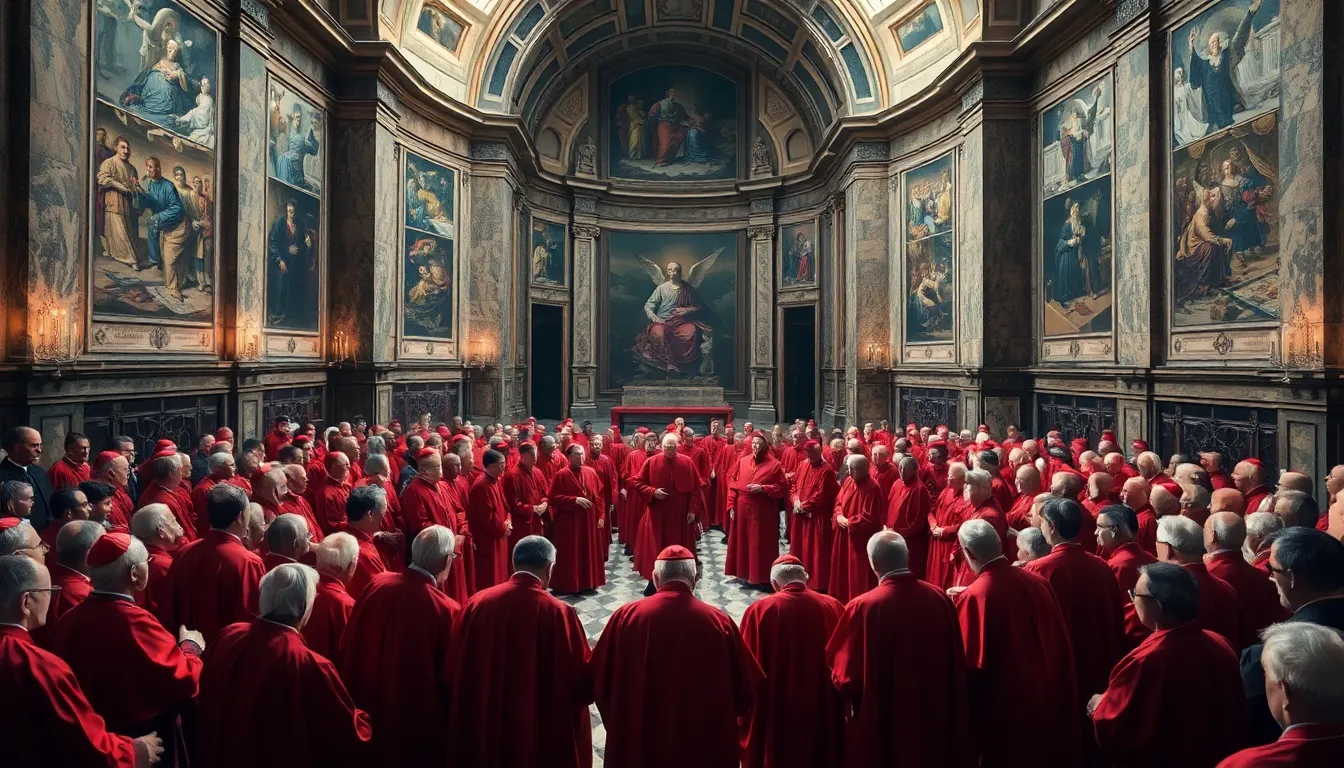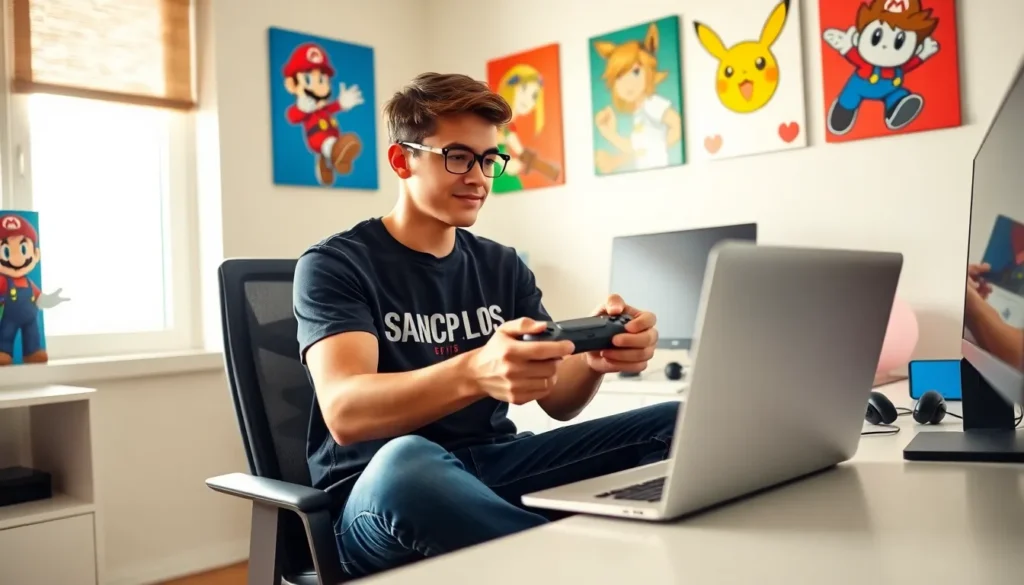In the grand theater of the Vatican, the election of a pope is a spectacle that rivals any reality show. With cardinals donning their finest robes and the world holding its breath, the conclave is a blend of tradition, secrecy, and a dash of drama. So, when was the last pope elected? Spoiler alert: it was in 2013, when Jorge Mario Bergoglio, now known as Pope Francis, took the stage and instantly became a global superstar.
But hold onto your hats, because this isn’t just a history lesson. Understanding the timing and significance of papal elections gives insight into the Catholic Church’s evolving role in today’s world. Curious about the behind-the-scenes action? Buckle up, as we dive into the fascinating world of papal elections and what they mean for millions around the globe.
Table of Contents
ToggleOverview of Papal Elections
Papal elections occur when a Pope dies or resigns. The College of Cardinals, comprising about 120 members, gathers in the Vatican to elect a new Pope. This secluded event emphasizes tradition and secrecy, often taking weeks as cardinals debate and vote.
Voting occurs through a series of ballots, with the preferred candidate requiring a two-thirds majority to be elected. After each round, the results are announced using smoke signals. Black smoke indicates no election, while white smoke signals a new Pope.
Typically, elections begin with a mass in St. Peter’s Basilica. This sacred gathering fosters reflection among the cardinals, guiding them in their selections. Once elected, the new Pope accepts the role and chooses a papal name, marking the beginning of their leadership.
The last papal election took place in March 2013. Jorge Mario Bergoglio became Pope Francis, making history as the first pope from the Americas. His election symbolized a shift toward a more inclusive Catholic Church, addressing contemporary social issues.
Throughout history, the process of electing a Pope has evolved. Advances in communication and societal changes have shaped modern elections. The significance of these elections drives interest among millions of Catholics worldwide, highlighting this pivotal moment for the Church.
Historical Context

Papal elections hold deep historical significance, reflecting the evolution of the Catholic Church’s governance. The process has undergone various changes over centuries, influenced by both internal dynamics and external pressures.
Evolution of Papal Elections
Papal elections can trace roots back to the early Church, where bishops were chosen through local consensus. In the 11th century, the method transformed with the establishment of the College of Cardinals, professionalizing the electoral process. Cardinals began serving as electors, ensuring that theological and political considerations guided selections. As papal authority grew, the elections adopted more structured procedures, accommodating the Church’s expanding global presence. This evolution embraced enhanced secrecy and ritual, encapsulating the solemnity of the occasion while adapting to modern contexts.
Significant Electoral Changes
The election of Pope Francis in 2013 marked a pivotal shift in how papal choices reflect contemporary society. Innovations emerged, including the transparent use of media in relaying election news to a global audience. Previously, cardinals conducted discussions in isolation, but today’s interconnected world invites broader implications for Church visibility. Additionally, reforms initiated by Pope John Paul II and Pope Benedict XVI paved the way for a streamlined process. These reforms emphasized simplicity, allowing quicker transitions during vacancies. Each of these changes highlights the Church’s responsiveness to modern challenges while retaining deep-rooted traditions.
The Last Papal Election
The most recent papal election took place on March 13, 2013. This significant event followed the resignation of Pope Benedict XVI, a momentous decision marking the first voluntary resignation of a pope in nearly 600 years. The conclave convened in the Sistine Chapel, where cardinals gathered to select a successor amidst a backdrop of secrecy and tradition.
Date and Circumstances
The conclave started on March 12, 2013, with cardinals participating in morning and evening sessions. Black smoke emerged from the chimney of the Sistine Chapel during the initial ballots, indicating no election had occurred. The following day, however, white smoke signaled the successful election of a new pontiff. Pope Francis, once known as Jorge Mario Bergoglio, became the leader of the Catholic Church, bringing a wave of optimism and a call for reform.
Key Figures Involved
Cardinal Angelo Sodano served as the Dean of the College of Cardinals during the election. His leadership played a crucial role in guiding the proceedings. Cardinal Bergoglio, later named Pope Francis, emerged as a strong candidate amidst evolving dynamics. Voters included roughly 115 cardinals, reflecting diverse backgrounds and opinions, creating a vibrant tapestry of insight. Each participant brought unique perspectives, contributing to the collective decision-making process that ultimately shaped the Church’s future.
Impact of the Last Election
The election of Pope Francis on March 13, 2013, transformed the landscape of the Catholic Church. This pivotal moment stirred both hope and debate among the faithful.
Reactions from the Catholic Community
Immediate reactions from the Catholic community showcased widespread enthusiasm. Many expressed joy over the election of the first pope from the Americas. Feelings of hope emerged, particularly among those seeking reform within the Church. Various groups, including clergy and laypeople, highlighted Francis’ emphasis on social justice and humility. Additionally, online discussions erupted, reflecting varying perspectives on his approach to issues like interfaith dialogue and Church governance. Such passionate responses illustrated a deep engagement with the papacy in an evolving cultural context.
Global Significance
Pope Francis’ election resonated far beyond the Vatican. His selection symbolized a shift towards inclusivity and modernity within the Catholic Church. Leaders from diverse sectors acknowledged his potential to influence global conversations on morality and ethics. The pope’s focus on climate change and poverty addressed urgent global issues, positioning the Church as a vital player on the world stage. His outreach efforts fostered dialogue with other faiths, strengthening interreligious relationships. Furthermore, his leadership style encouraged broader participation, inspiring both Catholics and non-Catholics alike to consider the role of faith in addressing contemporary challenges.
Future of Papal Elections
Papal elections will continue to evolve alongside the changing dynamics of the Catholic Church and global society. As societal values shift, so may the expectations surrounding future popes and their governance. The ongoing dialogue about transparency and accountability has already begun influencing the electoral process, possibly leading to reforms that enhance openness in papal selection.
Technology plays a pivotal role in shaping the future of these elections. Digital communication could facilitate greater engagement among cardinals and with the global community, enabling more voices to be heard during deliberations. Innovations may also lead to new methods of announcing results that resonate with a modern audience accustomed to immediate updates.
The College of Cardinals is likely to reflect broader diversity over time. Increased representation from different regions and backgrounds could enrich discussions and decision-making, fostering inclusion within the Church. Changes in cardinal nominations may further diversify perspectives, helping the Church address contemporary issues more effectively.
Anticipated reforms may result in a quicker election process. Many cardinals have voiced support for streamlining ballots and reducing the number of voting sessions, promoting efficiency while honoring tradition. Changes may also empower cardinals to emphasize communal discernment, ensuring that the selected leader aligns with the Church’s mission and vision.
Engaging young Catholics could prove crucial for the future of papal elections. Balancing tradition with modern values, outreach to younger generations may enhance interest in Church governance. This engagement could inspire a more active role among youth, shaping the expectations surrounding future leaders.
Anticipatory shifts in papal elections reflect a broader desire for the Catholic Church to adapt while remaining rooted in its history. Addressing contemporary challenges effectively requires a willingness to innovate while honoring the core mission of the Church.
The election of Pope Francis in 2013 marked a pivotal moment in the history of the Catholic Church. His leadership has not only inspired hope among the faithful but also prompted discussions about the Church’s role in addressing pressing global issues. As the Church continues to navigate the complexities of modern society, the future of papal elections will likely evolve alongside these changes.
With an emphasis on inclusivity and reform, the upcoming elections may reflect a broader diversity within the College of Cardinals. Engaging younger generations and embracing technology will play crucial roles in shaping the Church’s direction. The journey of papal elections remains a fascinating intersection of tradition and modernity, inviting ongoing reflection and dialogue among Catholics and the wider world.







